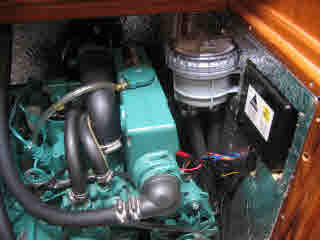Technical
Read about technical aspects discovered by our members. Note some articles may appear under more than one category.
 Some time ago there was some discussion about fitting sea water filters to the Maxi 1100 Volvo 2030 diesel. Most owners would want to fit one even if the risk of blockage is low (as it is here on the W Coast of Scotland).
Some time ago there was some discussion about fitting sea water filters to the Maxi 1100 Volvo 2030 diesel. Most owners would want to fit one even if the risk of blockage is low (as it is here on the W Coast of Scotland).
The Volvo Penta MD22L fitted to the Maxi 38 has a 18mm diameter core plug fitted to the heat exchanger… and is virtually inaccessible. The plugs rarely (if ever) fail and so they are not available as spares. So read how Caorann spent £166 searching for a solution that did not necessitate removing or replacing the whole heat exchanger. The solution is to tap the plug hole and fit a new threaded plug…
A number of Maxi 95 owners have had to replace their cabin windows and various ideas have emerged on suitable materials. One such material is “Lexan”, a high impact polycarbonate sheet. Another Maxi sourced some material from “Talking Plastics” in Havant.
More recently, Ken Johnson suggests that “GE (GENERAL ELECTRIC) MARGUARD a polycarbonate with anti scratch and chemical resistant coating is available from a supplier in Hull (look on Ebay for address) for around £100 for one boat. Easily cut and drilled, don’t use acrylic, as it’s not strong enough.”
We adopted an alternative solution on our Maxi 1100. We’ve strapped a cheap B&Q domestic dehumidifier to a backing sheet which is mounted under the starboard flap of the saloon table. It’s mounted a couple of inches above the floor so you don’t lose too much space for feet, and a permanent drain is made very neatly via plastic tubing into the bilge by the float switch. It’s run via a time clock every few days when we’re not on board. When we are, we can always run overnight to help keep the inside sweet and dry.
Obviously you can’t lower the flap with it in place but it can be quickly and easily removed with just two small neat screws underneath the table.
We wouldn’t recommend running it when stored ashore as I prefer to keep the bilge dry in case it freezes. In fact, what we do is to lash it over the sink so that the condensate can drain directly out – but be sure to leave the sink seacock open. Even cheap dehumidifiers can be bought that have a frost setting that ensures there is no ice build-up.
Vouvray
Sometimes the hob burners won’t stay lit when the knob is released:
Solution: Hold the knob in, light the gas and after waiting 5 seconds for the flame sensor to heat up, let the knob out about 1 mm (1/16″) and then press the knob back in sharply, then release the knob.
The oven and grill won’t stay lit when the knob is released.
If you have a cooker with metal knobs the oven/grill knob may be fixed too far in on the shaft preventing the flame detection mechanism from engaging. Solution is to loosen the knob retaining screw (using an allen key) and move the knob back on the shaft, then tighten the screw. You should have the same or slightly larger gap between the knob and cooker as that for the burner knobs.
Taranaki
